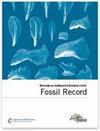下载PDF
{"title":"一条产自Rösenbeck(德国莱茵山脉)的早石炭世幼鱼腔棘鱼,具有派生的颅后特征","authors":"Florian Witzmann, Markus Dorka, Dieter Korn","doi":"10.1002/mmng.201000004","DOIUrl":null,"url":null,"abstract":"<p>A small coelacanth specimen of Viséan age from a newly described locality near Rösenbeck at the northern margin of the Rhenish Mountains (North Rhine-Westphalia, Germany) is described. The head and pectoral girdle are not preserved, however, the specimen can be distinguished from all other known Carboniferous coelacanths by derived characters of the articulated postcranial skeleton. Derived characters include: (1) The slender first and second dorsal fins that carry only seven to eight and six fin rays, respectively. (2) Both the pelvic and anal fin have a broad base and are unusually weakly lobed. (3) The fin rays of the second dorsal fin are much more robust than those of the first dorsal fin. (4) The second dorsal and anal fins are longer than the first dorsal and pelvic fins. The Rösenbeck coelacanth is interpreted as a juvenile specimen, since the basal plates that support the fins are not ossified. (© 2010 WILEY-VCH Verlag GmbH & Co. KGaA, Weinheim)</p>","PeriodicalId":55147,"journal":{"name":"Fossil Record","volume":null,"pages":null},"PeriodicalIF":1.4000,"publicationDate":"2010-08-05","publicationTypes":"Journal Article","fieldsOfStudy":null,"isOpenAccess":false,"openAccessPdf":"https://sci-hub-pdf.com/10.1002/mmng.201000004","citationCount":"6","resultStr":"{\"title\":\"A juvenile Early Carboniferous (Viséan) coelacanth from Rösenbeck (Rhenish Mountains, Germany) with derived postcranial characters\",\"authors\":\"Florian Witzmann, Markus Dorka, Dieter Korn\",\"doi\":\"10.1002/mmng.201000004\",\"DOIUrl\":null,\"url\":null,\"abstract\":\"<p>A small coelacanth specimen of Viséan age from a newly described locality near Rösenbeck at the northern margin of the Rhenish Mountains (North Rhine-Westphalia, Germany) is described. The head and pectoral girdle are not preserved, however, the specimen can be distinguished from all other known Carboniferous coelacanths by derived characters of the articulated postcranial skeleton. Derived characters include: (1) The slender first and second dorsal fins that carry only seven to eight and six fin rays, respectively. (2) Both the pelvic and anal fin have a broad base and are unusually weakly lobed. (3) The fin rays of the second dorsal fin are much more robust than those of the first dorsal fin. (4) The second dorsal and anal fins are longer than the first dorsal and pelvic fins. The Rösenbeck coelacanth is interpreted as a juvenile specimen, since the basal plates that support the fins are not ossified. (© 2010 WILEY-VCH Verlag GmbH & Co. KGaA, Weinheim)</p>\",\"PeriodicalId\":55147,\"journal\":{\"name\":\"Fossil Record\",\"volume\":null,\"pages\":null},\"PeriodicalIF\":1.4000,\"publicationDate\":\"2010-08-05\",\"publicationTypes\":\"Journal Article\",\"fieldsOfStudy\":null,\"isOpenAccess\":false,\"openAccessPdf\":\"https://sci-hub-pdf.com/10.1002/mmng.201000004\",\"citationCount\":\"6\",\"resultStr\":null,\"platform\":\"Semanticscholar\",\"paperid\":null,\"PeriodicalName\":\"Fossil Record\",\"FirstCategoryId\":\"89\",\"ListUrlMain\":\"https://onlinelibrary.wiley.com/doi/10.1002/mmng.201000004\",\"RegionNum\":4,\"RegionCategory\":\"地球科学\",\"ArticlePicture\":[],\"TitleCN\":null,\"AbstractTextCN\":null,\"PMCID\":null,\"EPubDate\":\"\",\"PubModel\":\"\",\"JCR\":\"Q3\",\"JCRName\":\"Earth and Planetary Sciences\",\"Score\":null,\"Total\":0}","platform":"Semanticscholar","paperid":null,"PeriodicalName":"Fossil Record","FirstCategoryId":"89","ListUrlMain":"https://onlinelibrary.wiley.com/doi/10.1002/mmng.201000004","RegionNum":4,"RegionCategory":"地球科学","ArticlePicture":[],"TitleCN":null,"AbstractTextCN":null,"PMCID":null,"EPubDate":"","PubModel":"","JCR":"Q3","JCRName":"Earth and Planetary Sciences","Score":null,"Total":0}
引用次数: 6
引用
批量引用


